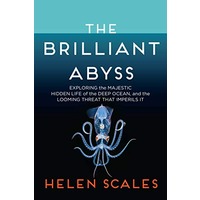The Brilliant Abyss by Helen Scales EPUB & PDF – eBook Details Online
- Authors: Helen Scales
- Language: English
- Genre: Marine Biology
- Format: PDF / EPUB
- Size: 2 MB
- Pages:
- Price: Free
- Publish Date: February 18, 2021
Here is the Deep
water planet. Seven-tenths of the surface is covered in what we see as blue
ocean. Blue light from the sun seeps down through the seawater, leaving all
the other colours behind in the shallows, where they’re absorbed by
vibrating molecules of H20. The tenacity of those longer wavelengths of
light, 450 nanometers and longer, gives Earth its particular shade of blue.
But even those deepest-diving photons can go only so far. Below the first
200 metres—roughly the long side of a Chicago city block,—weak
remnants of dim blue sunlight remain. Below that depth, physical
conditions shift and oceanic life becomes distinct from the shallower,
surface seas. This is where the deep sea officially begins.
On average, the oceans are around 3,000 metres deep, or close to two and
a half miles, ten times the height of the Empire State Building in New York.
Below about 1,000 metres there are no sunbeams at all, which means that a
huge portion of the planet is untouched by sunlight. Far more permanent
night fills up our world than day, but most of us don’t see those dark parts
or what lies within them.
It’s often said that more is known about the surface of the moon than the
bottom of the sea, and there is truth in this. The whole of the moon has been
mapped to a resolution of 7 metres. Meanwhile, the best map of the entire
deep seabed shows only features larger than 4.8 kilometres across. But the
astronomical comparison rather misses the point, partly because of the
gaping size difference between the lunar and abyssal maps. If the moon’s
surface could be peeled off and laid out on the deep seabed, it would fit
almost ten times over.
1 And even though it lies a lot further away than the
deep seabed, the moon is also a great deal easier to map than the deep,
because it’s bone-dry, with no oceans or lakes in the way. With a telescope
and a clear night, any of us can get a reasonable idea of what the near side
of the moon looks like (accessing the dark side is rather more involved).
Try doing the same for the deep seabed.
Were our view not blocked by its cloak of water—blue above, black
below—Earth would look very different. We would see the complex
topography of the deep ocean floor laid out in a spectacular terrain.
For More Read Download This Book
EPUB



